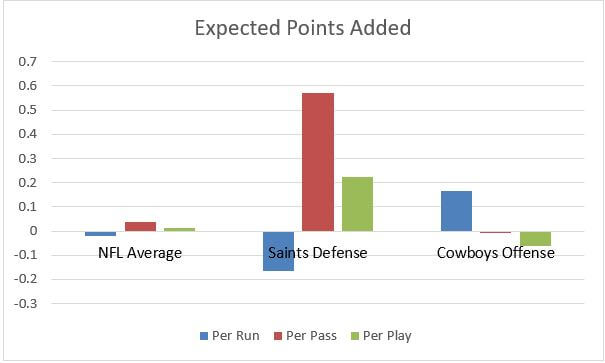Run the ball. Stop the run. Win games. Right?
Well, the New Orleans Saints come into Week 4 of the NFL season with a 2-1 record thanks to their league leading run defense that’s allowed just 3.0 yards per carry.
What’s that? They’ve allowed the most points in the NFL through 3 weeks? That can’t be right…
The Dallas Cowboys are league leaders in yards per carry, averaging 6.0 yards per attempt, and they’re off to a great start, right? Right?!
Let’s take a quick aside and come back to these questions in a minute.
What is EPA?
As has happened in baseball, people have realized that boxscore stats miss a lot of the story. Throwing a 15-yard completion on third-and-20 from your own 20-yard line is worth a lot less than a 7-yard pass on third-and-six from midfield, even though the former looks better in the boxscore. Expected Points Added – EPA - tries to solve this dilemma. Using historical data, you estimate what the average next score will be - that’s a team’s “expected points”. Compare expected points before and after a play and the difference is EPA.
Back to those run-stopping Saints
First, let’s use EPA to compare the value of running versus passing. So far in 2018, the average dropback to pass (including sacks, of course) is worth about 0.036 points. The average run this year is net negative, losing a little more than 0.02 points per attempt.
The Saints rank second in run defense and their opponents have lost almost 14 expected points through their runs. Unfortunately, pass defense is much more important. They’ve given up 53 expected points through the air - 31st in the NFL. Similar story for the Cowboys. They’re doing well running the ball but can’t pass. The result isn’t pretty.
We can see the effects of this in the leaders in EPA. In 2017, eight of the top 10 teams in pass EPA made the playoffs, including the Eagles, Patriots, Steelers and Vikings. What about running EPA leaders? Only four teams had positive running EPA: Cowboys, Packers, Saints and Browns. Not quite as impressive a list.
How to Use EPA as a sports bettor?
Expected Points Added mainly takes some of the noise out of the traditional stats by looking at the situation in which a play occurred. You can go further and cut the value of garbage time production, but those points count towards the spread too, so standard EPA is good for our purposes. Here’s how it could impact your NFL Week 4 bets:
Kansas City Chiefs -5.5 at Denver Broncos
The high-flying Chiefs face the vaunted Denver pass defense, but how good is that defense? In 2017 they ranked 13th is pass defense by EPA, with teams losing about a point in EPA per game. In 2018 so far, they’ve given up more than 5.5 EPA per game through the air to the Seahawks, Raiders and Ravens. The Chiefs averaged close to seven EPA per game through the air last year and more than 17 so far in 2018. Denver’s defense had better step it up or this game will get ugly.
Miami Dolphins +7 at New England Patriots
This one doesn’t feel right to me but generally I trust numbers over my gut. The Patriots are really struggling. In 2017, they led the NFL in offensive EPA at 8-plus per game. This year they rank 18th at -1.6 per game and have just lost another weapon with Rex Burkhead hitting IR. The Dolphins offense isn’t that much better by EPA in 2018 but they rank third in defensive EPA allowed – admittedly against some weaker competition. Still, unless you’re fully aboard the Josh Gordon hype train, seven points are just too much.
Cleveland Browns +3 at Oakland Raiders
Oakland is bad. The Raiders were bad last year (26th in total EPA) and they’re bad this year (29th). Cleveland was terrible last year (31st by EPA) but most of the problem was passing the ball. This year, the Browns have been very good in all areas except throwing the football. Enter Baker Mayfield. The Raiders are getting the already too big 3-point “standard” home field edge and quite simply don’t deserve it.





















